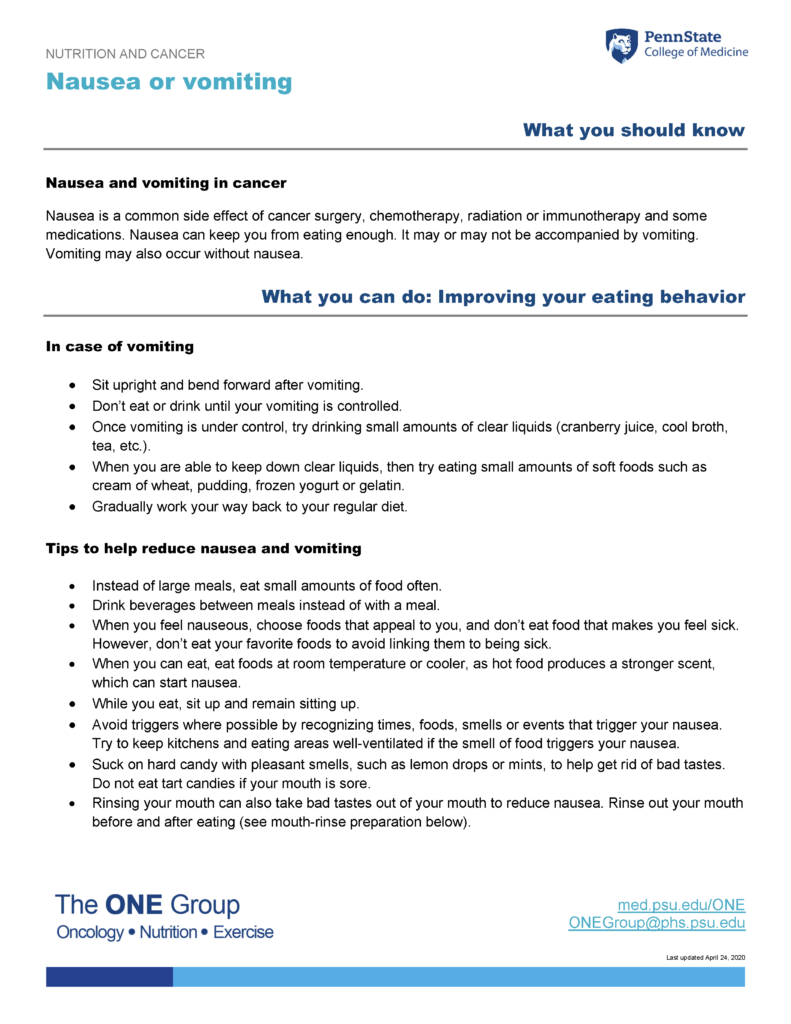Learn about nausea or vomiting in people with cancer in this guide from The ONE Group (Oncology – Nutrition – Exercise) at Penn State College of Medicine.
Jump to topic
Search
What you should know
Nausea and vomiting in cancer
Nausea is a common side effect of cancer surgery, chemotherapy, radiation or immunotherapy and some medications.
Nausea can keep you from eating enough.
It may or may not be accompanied by vomiting.
Vomiting may also occur without nausea.
What you can do: Improving your eating behavior
In case of vomiting
- Sit upright and bend forward after vomiting.
- Don’t eat or drink until your vomiting is controlled.
- Once vomiting is under control, try drinking small amounts of clear liquids (cranberry juice, cool broth, tea, etc.).
- When you are able to keep down clear liquids, then try eating small amounts of soft foods such as cream of wheat, pudding, frozen yogurt or gelatin.
- Gradually work your way back to your regular diet.
Tips to help reduce nausea and vomiting
- Instead of large meals, eat small amounts of food often.
- Drink beverages between meals instead of with a meal.
- When you feel nauseous, choose foods that appeal to you, and don’t eat food that makes you feel sick. However, don’t eat your favorite foods to avoid linking them to being sick.
- When you can eat, eat foods at room temperature or cooler, as hot food produces a stronger scent, which can start nausea.
- While you eat, sit up and remain sitting up.
- Avoid triggers where possible by recognizing times, foods, smells or events that trigger your nausea. Try to keep kitchens and eating areas well-ventilated if the smell of food triggers your nausea.
- Suck on hard candy with pleasant smells, such as lemon drops or mints, to help get rid of bad tastes. Do not eat tart candies if your mouth is sore.
- Rinsing your mouth can also take bad tastes out of your mouth to reduce nausea. Rinse out your mouth before and after eating (see mouth-rinse preparation below).
Make a daily mouth rinse
Mix well together:
4 cups warm water
1 tsp. salt
1 tsp. baking soda
Instructions:
Swish a mouthful (for 15 seconds), then spit out the mouth rinse. Do this at least three to five times a day, rewarming as needed.
Foods to try
Try to eat bland food such as toast, saltine crackers, dry cereal and oatmeal. Drink mostly clear liquids, such as water, broth, cranberry juice and flat soda. Soft foods are more easily eaten, such as yogurt, sorbet, popsicles and canned fruits. To keep protein intake high, eat skinless chicken (not fried).
Foods to avoid
Avoid eating fatty, greasy and fried food, including most fast food. Spicy foods also can aggravate nausea, along with foods with strong odors. Foods high in sugar such as candy, cake and rich desserts should be avoided.
Recipe
Banana Milkshake
Blend ingredients well:
1 peeled ripe banana
A few drops of vanilla extract
1 cup whole milk
Nutrition facts:
Serving size: 2 cups
Calories: 255
Protein: 9 grams
Notes
Contact your physician if:
You are considering using anti-nausea medications. If you have persistent vomiting and cannot keep liquids down, contact your physician, because it is important to prevent dehydration and unintended weight loss.
References
- Academy of Nutrition and Dietetics
- American Cancer Society
- American Institute for Cancer Research
- National Cancer Institute

